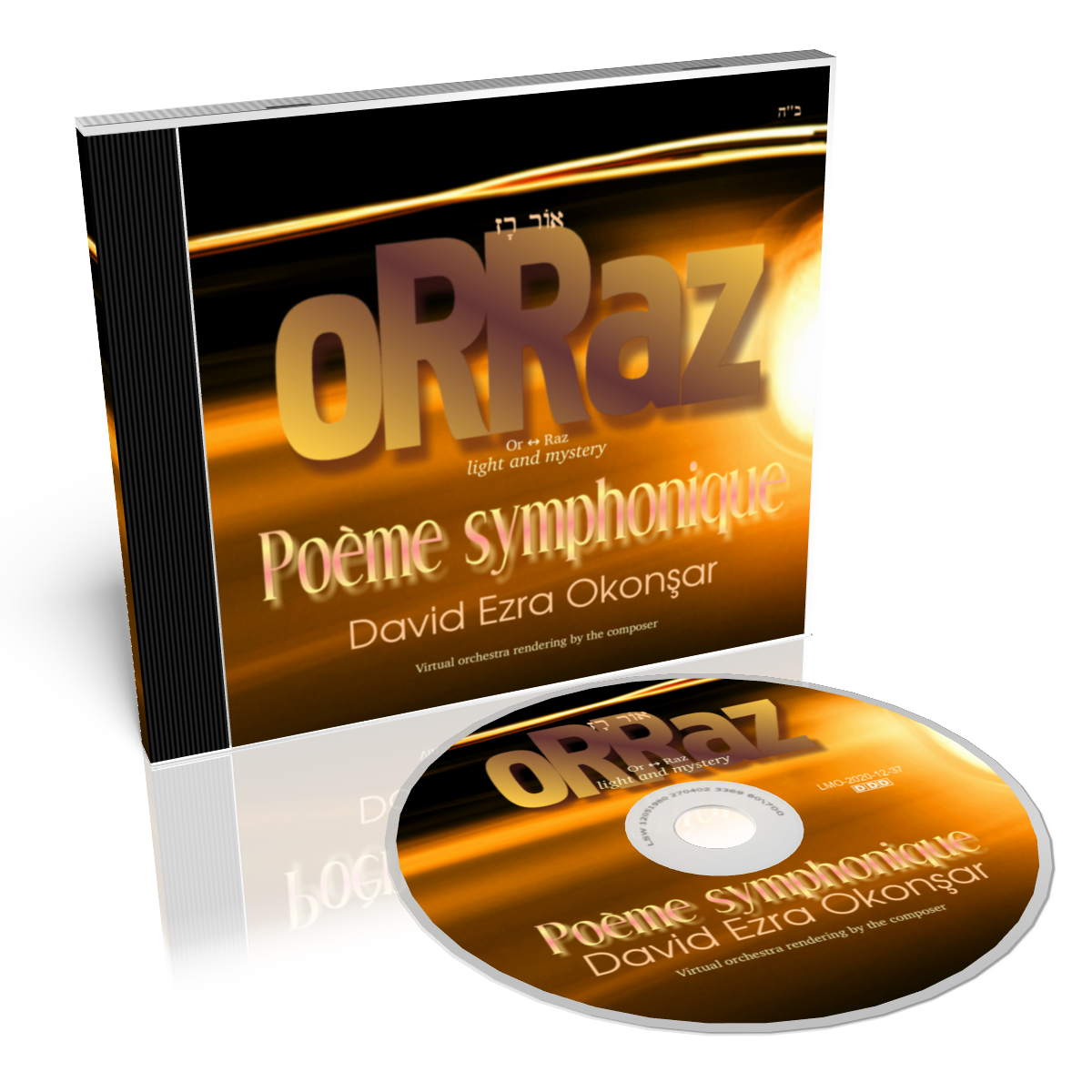for Large Orchestra:
ORRAZ (Light and Mystery)
the virtual instruments CD
for composition details click here


|
oRRaz "Light and Mystery", Poème Symphonique
I. Animato207 OR (light) : אוֹר 1 Aleph א 6 Vav ו 200 Reish ר RAZ (secret/mystery) : רָז 200 Reish ר 7 Zayin The earth joins battle
in its armor of darkness;
The stars hurl their javelins of light. The moon flees and grows dim, But now she stands on the face of the sky Like a golden brooch on a cloak, Her face red with the dust of battle Like the face of a queen leading her armies. II. Presto The moon is conspiring
against the sun, her king.
She thinks he has gone traveling in the Western Sea And drowned. Unsheathing her swords of lightning She strikes the earth’s back with her staffs of fire. The lightning bolts dance, Swirl their golden skirts and sway. III. Allegro molto There is a fragrance
like incense or myrrh.
Has Solomon sent me a poem, perfumed, wrapped to a pigeon-dove’s leg? From the poem’s lines of black letters, greetings break forth like the dawn, Light amid the grey morning, Letters ink-black as night, but words bright as the dawn, Like a girl who hides her cheeks behind her dark hair. IV. Poco animato His poem is like a
tapestry woven by the hands of thought,
Framed with beauty, Worn like a crown. His poem is like a song of jeweled fruit, A song, a poem for the reader to taste. My tongue shall sing it on a glass of wine. from: Ayin Nedivah (“Generous Eye”); Qasida for Solomon Ibn Ghiyyat Yehudah Halevi (1075/86 - 1141) Trad. Joseph Davis (used by permission) The symphony is inspired by the work of Yehudah Halevi (1075/86 - 1141) Spanish Jewish physician, poet and philosopher. Specifically the Ayin Nedivah (“Generous Eye”) a Qasida For Solomon Ibn Ghiyyat; as well as the Gematria relationship between the Hebrew letters making for “or” (light) and “raz” (secret – mystery). A qasida is an ancient Arabic word and form of writing poetry, often translated as ode. The classic form of qasida maintains a single elaborate metre throughout the poem, and every line rhymes on the same sound. The numerical values of Hebrew letters is well known from time immemorial. Adding these numbers in a word or a phrase and looking for similarities in other words is known as Gematria. Gematria originated as an Assyro-Babylonian-Greek system of alpha-numeric code or cipher that was later adopted into Jewish culture[wp]. The Hebrew words OR (light) and RAZ (secret, mystery) share the same numerical values (207) obtained by adding the numbers corresponding to their letters. [wp]: wikipedia.org Light and secrecy do seem rather opposite. Light involves openness while secrecy or mystery seems to be related with darkness or the opposite of light. Tzvi Freeman relates in chabad.org: Everything begins with light, and light is the destiny of all things. “In the beginning, G‑d created the heavens and the earth.” And what is the first thing G‑d said? “Let there be light!” [..] So this is the secret of life: that each thing holds its own secret. And this is how the story unfolds: Through our struggle with life and with the world, we crack its shell and get that secret out into the open. The secret of all darkness is that it desires to become light; the secret of all conscious beings is that they must perceive that light; the secret of all existence is to know that it emerges out of that which stands beyond existence. Those who know the secret reveal the light. Those who have light reveal the secret. Until eventually that light shines, everywhere and through everything. Ohr ("Light" Hebrew: אור; plural: Ohros/Ohrot "Lights" אורות) is a central Kabbalistic term in the Jewish mystical tradition. The analogy of physical light is used as a way of describing metaphysical Divine emanations. Shefa ("Flow" שפע and its derivative, Hashpoah "Influence" השפעה) is sometimes alternatively used in Kabbalah, a term also used in Medieval Jewish philosophy to mean Divine influence, while the Kabbalists favour Ohr because its numerical value equals Raz ("mystery"). It is one of the two main metaphors in Kabbalah for understanding Divinity, along with the other metaphor of the human soul-body relationship for the Sephirot. The metaphorical description of spiritual Divine creative-flow, using the term for physical "light" perceived with the eye, arises from analogous similarities. These include the intangible physicality of light, the delight it inspires and the illumination it gives, its apparently immediate transmission and constant connection with its source. Light can be veiled ("Tzimtzum"-constrictions in Kabbalah) and reflected ("an ascending light from the Creations" in Kabbalah). White light divides into 7 colours, yet this plurality unites from one source. Divine light divides into the 7 emotional Sephirot, but there is no plurality in the Divine essence. The term Ohr in Kabbalah is contrasted with Ma'ohr, the "luminary", and Kli, the spiritual "vessel" for the light. https://en.wikipedia.org/wiki/Ohr
|
||||||||||||
|





